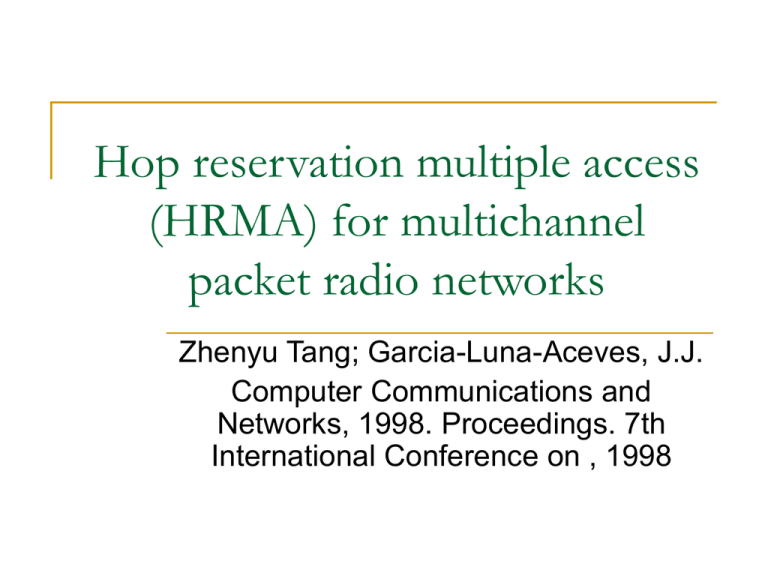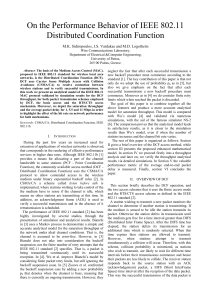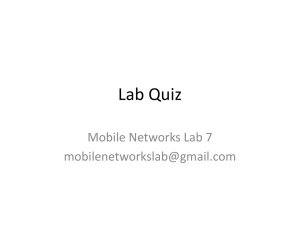(HRMA) for multichannel packet radio networks
advertisement

Hop reservation multiple access (HRMA) for multichannel packet radio networks Zhenyu Tang; Garcia-Luna-Aceves, J.J. Computer Communications and Networks, 1998. Proceedings. 7th International Conference on , 1998 Outline Introduction HRMA Protocol Comparative Throughput Analysis Numerical Results Conclusions Introduction(1) radios operate using two spread spectrum direct-sequence spread spectrum (DSSS) frequency-hopping spread spectrum (FHSS) focuses on an efficient MAC protocol based on FHSS radios operating prior examples of MAC protocols ALOHA slotted ALOHA sender- or receiver-oriented code assignments Introduction(2) proposed paper based on very slow frequency hopping allows to reserve a frequency hop (channel) provides a baseline to offer QoS in ad hoc networks based on simple half-duplex slow FHSS radios HRMA Protocol(1) based on common hopping sequence no carrier sensing L available channel Denote by f0 the synchronization channel exchange synchronization information synchronization period beginning of a frequency hop and the current hop the rest channels HRMA Protocol(2) the rest channels frequency pairs (fi,fi*),i=1,2…….M frequency hop fi frequency hop fi* HR packet, RTS, CTS, data packet ACK packet HRMA slot synchronization period HR period (Hop Reservation) RTS period CTS period HRMA Protocol(3) HRMA Protocol(4) new node to join with HRMA create one-node system HRMA Protocol(5) backoff during CTS preiod t7 S_RTS WF_CTS t2 t11 t9 t12 t5 t4 t2 WF_HR t4 t10 t8 more data WF_DATA t13 t1 t3 t6 S_HR idle end of transmission S_DATA t1:receive RTS, send CTS in CTS period t2:receive CTS, send data t3:more data, send HR in the next HR period t4:LD before RTS period and HR, send RTS in RTS period t5:the reserved slot starts and HR, send RTS immediately t6:data received or timeout and LD t7:timeout and HR, send RTS in RTS period t8:more data , send HR in the reserved slot of next HR frame t9: timeout and LD t10:end of transmission and no more data t11: t 7 and receive RTS, send CTS in CTS period t12:after CTS period of the reserved slot t13:end of HR packet transmission no synchr. infor. , send synchr. packet join start synchr. infor. HRMA Protocol(6) t1:receive RTS, send CTS in CTS period t2:receive CTS, send data t3:more data, send HR in the next HR period t4:LD before RTS period and HR , send RTS in RTS period t5:the reserved slot starts and HR, send RTS immediately t6:data received or timeout and LD t7:timeout and HR, send RTS in RTS period t8:more data , send HR in the reserved slot of next HR frame t9: timeout and LD t10:end of transmission and no more data t11: t 7 and receive RTS, send CTS in CTS period t12:after CTS period of the reserved slot t13:end of HR packet transmission Comparative Throughput Analysis(1) assumption N nodes, M frequency hops a fully-connected network Radios are half-duplex M>N a typical multi-hop packet radio network compared protocol ideal protocol with ROCA ALOHA with ROCA Comparative Throughput Analysis(2) ROCA (receiver-oriented channel assignment) unique channel to receive tunes its radio to the channel of the intended receiver to transmit a packet two possible types of conflict two or more nodes try to start sending packets to the same receiver at the same slot. the destination is transmitting or receiving Comparative Throughput Analysis(3) ideal protocol with ROCA there is no the two conflicts of ROCA when the first conflict happens, the ideal protocol can randomly pick one competing sender block all the attempting senders when the second case happens The only issue that affects the throughput is the pair-up of nodes Comparative Throughput Analysis(4) ALOHA with ROCA consider here a slotted ALOHA assumption transmitting has the highest priority transmitting preempts any receiving Numerical Results(1) network parameters M : frequency hops available N : the number of nodes APL : value of average packet length depict the throughput per node (S) as a function of offered load (G) Numerical Results(2) Throughput of HRMA with different values of APL Numerical Results(3) Throughput of HRMA with different numbers of nodes Numerical Results(4) Throughput of HRMA with different numbers of channels Numerical Results(5) Throughput of Ideal protocol with different population and APL’s Numerical Results(6) Throughput of ALOHA with different population and APL’s 2 4 10 Numerical Results(7) Throughput comparison: HRMA, Ideal and ALOHA Conclusion offer QoS in ad hoc networks reserve a frequency hop better with large data packet continues to develop multi-hop packet-radio networks











